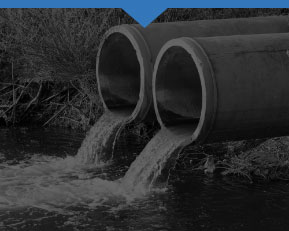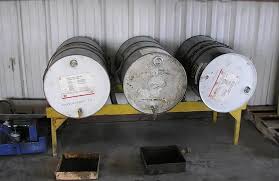Intro
In the State of Texas, managing stormwater runoff is a critical concern for industrial facilities. An Industrial SWPPP, or Stormwater Pollution Prevention Plan, is essential in preventing pollutants from contaminating water sources. In Texas, the Stormwater Pollution Prevention Plan is crucial due to the diverse weather patterns and the potential for intense storms.
When it comes to your Industrial SWPPP, you have a couple of options.
1. You can hire an outside company or consultant to conduct your inspections and write your SWPPP. This is sometimes an option, but it can be an expensive option.
2. You can get trained and certified to conduct your SWPPP yourself.
This blog post will guide you through the intricacies of the Texas Industrial Stormwater SWPPP, helping you understand its importance and implementation.
Understanding Stormwater Pollution Prevention
Stormwater pollution happens when rainwater flows over surfaces like roads, roofs, and industrial sites, collecting contaminants along the way. These pollutants can include chemicals, oils, heavy metals, and sediment, which eventually make their way into local waterways. Industrial activities are particularly prone to generating significant amounts of stormwater pollution due to the nature of the materials handled and the processes involved.
To combat this, the Industrial SWPPP is employed as a strategic approach. It focuses on identifying potential pollutant sources and implementing measures to control and reduce their impact. This includes outlining specific practices and procedures that facilities must follow to manage stormwater effectively.

For instance, good housekeeping practices such as regular cleanup, proper storage of materials, and maintenance of equipment can substantially reduce the chances of pollutants being picked up by stormwater. Structural measures like installing silt fences, sediment traps, and retention basins further help in managing stormwater runoff.
The goal is to not only comply with regulatory requirements but also to protect the environment by keeping pollutants out of natural water systems. This involves a combination of immediate actions and long-term strategies aimed at minimizing the environmental footprint of industrial activities.
By focusing on prevention, facilities can significantly reduce their contribution to stormwater pollution. Implementing employee training programs such as The Stormwater Training Center, is also essential to ensure that everyone understands the importance of stormwater management and knows how to properly implement the SWPPP measures. Additionally, ongoing monitoring and regular inspections help to identify any potential issues early, allowing for timely adjustments to be made.
Regulatory Requirements in Texas
The Texas Commission on Environmental Quality (TCEQ) enforces stringent regulations to manage stormwater runoff from industrial facilities. To comply, facilities must develop a Stormwater Pollution Prevention Plan (SWPPP) that addresses site-specific conditions and potential pollutant sources. This plan is essential for obtaining the required Texas Pollutant Discharge Elimination System (TPDES) permit, which authorizes the discharge of stormwater under regulated conditions.
The SWPPP must include several critical elements, such as identifying areas where pollutants are likely to be exposed to stormwater, describing best management practices (BMPs) to minimize pollutant discharge, and establishing procedures for regular monitoring and reporting. Facilities are also required to perform periodic inspections to ensure the effectiveness of the SWPPP and maintain detailed records of all activities related to stormwater management.

TCEQ mandates that facilities conduct annual comprehensive site evaluations and document any necessary revisions to the SWPPP based on these assessments. Facilities must also ensure that their employees are trained on stormwater management practices and the specifics of their SWPPP. Non-compliance can result in significant penalties, making adherence to these regulatory requirements not just an environmental responsibility but also a legal obligation.
By meeting these regulatory standards, industrial facilities in Texas contribute to protecting local water quality and promoting sustainable environmental practices.
Key Components of a SWPPP
A comprehensive SWPPP in Texas must outline potential pollutant sources, describe best management practices (BMPs) to minimize these pollutants, and establish procedures for monitoring and reporting. Each SWPPP should be facility-specific, tailored to address the unique challenges and characteristics of the site. Identifying areas where pollutants may be exposed to stormwater is crucial, as this helps in pinpointing vulnerable spots that need attention.
According to The Stormwater Training Center, best Management Practices (BMPs) are a core element of any SWPPP. These practices range from structural solutions, such as retention basins and silt fences, to procedural actions like regular site inspections and proper material storage. The BMPs must be clearly documented in the SWPPP, outlining how they will be implemented and maintained.

Another critical component is employee training. Staff must be educated on the specifics of the SWPPP and the importance of their roles in preventing stormwater pollution. This includes training sessions and ongoing awareness programs to keep everyone informed and engaged.
Record-keeping is also essential, ensuring that all actions related to stormwater management are documented. This includes records of inspections, training sessions, and any incidents of non-compliance. Accurate documentation helps in regulatory reporting and in assessing the effectiveness of the SWPPP over time.

Finally, the SWPPP must include a plan for regular site assessments and updates, ensuring that it remains effective and compliant with any changes in regulations or facility operations.
Conducting Site Assessments
Conducting site assessments is a critical component in crafting an effective SWPPP. This process begins with a detailed evaluation of the facility’s layout, operations, and materials. By understanding how water flows across and through the site, you can identify areas where stormwater is most likely to come into contact with pollutants. These evaluations should consider factors such as the types of materials stored, the location of industrial activities, and the topography of the site.
During the assessment, it’s important to pinpoint areas where contaminants like oils, chemicals, and debris are likely to accumulate. Special attention should be given to high-risk zones such as loading docks, waste disposal areas, and storage yards. Documenting these findings helps in developing targeted strategies to minimize pollution risks.

Use tools like site maps and flowcharts to visualize water movement and potential pollutant pathways. These tools can also assist in planning structural BMPs like retention basins or silt fences and procedural BMPs such as regular inspections and maintenance routines. Collaboration with site personnel can provide valuable insights into everyday operations and potential vulnerabilities that might not be immediately obvious.
Periodic reassessments are necessary to account for changes in operations, materials, or site conditions. Keeping the assessment data up to date ensures that the SWPPP remains effective and compliant with both current regulations and best practices in stormwater management.
Identifying and Controlling Pollutant Sources
Identifying and controlling pollutant sources is a fundamental aspect of an effective SWPPP. The first step is to conduct a thorough assessment of the facility to pinpoint where pollutants originate, whether from specific processes, storage areas, or operational activities. Focus on high-risk zones like loading docks, waste disposal areas, and chemical storage sites, as these are common hotspots for potential pollutants.
Once pollutant sources are identified, implement control measures tailored to the specific risks they pose. For example, secondary containment systems can be installed around storage tanks to capture spills before they reach stormwater pathways. Regular maintenance and inspections of equipment help prevent leaks and spills, while proper material storage reduces the likelihood of contaminants being washed away by rain.
Non-structural BMPs also play a crucial role in controlling pollutants. This includes good housekeeping practices such as regular cleanup of debris and proper disposal of waste materials. Training employees on pollution prevention techniques ensures everyone is aware of their responsibilities in minimizing stormwater contamination. Contaminated stormwater has been identified as a vector for PCB transport to many estuaries impaired by PCBs.
Structural BMPs like retention basins, silt fences, and vegetated swales can be employed to physically manage and treat stormwater runoff. These measures help filter out contaminants before they enter local water systems. Each permit violation is punishable with fines of more than $66,000 a day.By combining both structural and non-structural approaches, facilities can create a robust strategy for controlling pollutant sources effectively.

Best Management Practices (BMPs)
BMPs, or Best Management Practices, are a cornerstone of effective stormwater management within an Industrial SWPPP. These practices are designed to mitigate the impact of stormwater runoff and prevent pollutants from entering local water systems. Structural BMPs, such as retention basins, silt fences, and vegetated swales, physically manage and treat stormwater, capturing sediments and filtering out contaminants before they reach water bodies.
In addition to structural solutions, non-structural BMPs are equally important. These include good housekeeping practices like regular site cleanups, proper waste disposal, and routine inspections to identify and address potential pollutant sources. Employee training programs also fall under non-structural BMPs, ensuring staff are knowledgeable about pollution prevention techniques and the facility’s specific SWPPP requirements.
Choosing the appropriate BMPs involves assessing the unique conditions and needs of the facility. For instance, a site with significant vehicular traffic might benefit from installing oil-water separators to capture hydrocarbons, while areas prone to soil erosion might require the implementation of erosion control measures such as terracing or the use of geotextiles.
Effective BMPs should be clearly documented within the SWPPP, detailing their implementation and maintenance procedures. Regular evaluation of BMPs helps in fine-tuning these practices, ensuring they remain effective over time and adapt to any changes in site conditions or regulatory requirements.
Employee Training and Awareness
Employee training and awareness are essential for the successful implementation of a SWPPP. Staff members should receive comprehensive training on pollution prevention techniques and the specifics of the facility’s SWPPP. This includes understanding how to identify potential pollutant sources, the proper handling and storage of materials, and the procedures for responding to spills or leaks. Training sessions should be interactive, utilizing real-life scenarios to help employees grasp the importance of their roles in stormwater management.
Additionally, ongoing awareness programs can help maintain a high level of engagement and responsibility among employees. These initiatives might include regular updates on environmental regulations, internal newsletters featuring tips on pollution prevention, and recognition programs for employees who demonstrate exemplary practices. By fostering a culture of environmental responsibility, facilities can ensure that all staff members are proactive in minimizing stormwater pollution.
Record Keeping and Reporting
Effective record keeping and reporting are crucial for ensuring compliance with stormwater management regulations and for assessing the effectiveness of the SWPPP. Facilities must meticulously document all activities related to stormwater management, including inspections, training sessions, and any instances of non-compliance. Accurate records not only support regulatory reporting but also serve as a valuable tool for ongoing evaluation and improvement of stormwater practices.
Key records to maintain include inspection logs, which detail the findings of regular site evaluations, and training records, which verify that employees have received the necessary education on pollution prevention and SWPPP procedures. Additionally, facilities should document maintenance activities for both structural and non-structural BMPs, ensuring that these measures are functioning as intended.
Incident reports are also essential, capturing details of any spills, leaks, or other pollutant discharges, along with the corrective actions taken. These reports help identify recurring issues and facilitate the development of targeted strategies to mitigate future risks.
Electronic record-keeping systems can enhance efficiency and accuracy, allowing for easier tracking and retrieval of information. Regular audits of the records can further ensure that all documentation is up-to-date and compliant with regulatory requirements. By maintaining comprehensive and organized records, facilities can effectively demonstrate their commitment to environmental stewardship and regulatory compliance.
Inspections and Monitoring
Conducting regular inspections and monitoring is vital for ensuring the ongoing effectiveness of your SWPPP. Inspections should be carried out by qualified personnel, such as a Stormwater Inspector, who are trained to identify potential issues and suggest corrective measures. These inspections typically include visual assessments of structural and non-structural BMPs to confirm they are functioning correctly and not in need of maintenance or repair.
Monitoring involves collecting and analyzing stormwater samples to assess the levels of pollutants. This data helps determine if the BMPs are effective in reducing contamination and complying with regulatory standards. Facilities should use the monitoring results to adjust their SWPPP as necessary, ensuring it remains responsive to any changes in site conditions or regulatory requirements.
Documentation of inspection and monitoring activities is crucial. Keep detailed logs of inspection findings, any corrective actions taken, and the results of stormwater sampling. These records are essential for demonstrating compliance during regulatory audits and for making informed decisions about future stormwater management strategies.
Using electronic systems for tracking inspection schedules and monitoring data can streamline the process, making it easier to maintain organized and accurate records. Regular reviews of this data will help in identifying trends or recurring issues, allowing for proactive management of stormwater pollution risks.
Updating and Revising the SWPPP
Updating and revising the SWPPP is a continuous process that ensures the plan remains effective and compliant with current regulations. Changes in facility operations, site conditions, or the introduction of new materials can create new sources of pollutants or alter existing risks. Regular reviews and updates are essential to address these changes and to incorporate lessons learned from ongoing monitoring and inspections.
Start by scheduling periodic reviews of the SWPPP, at least annually or whenever significant changes occur. During these reviews, assess the effectiveness of existing BMPs and identify areas for improvement. Update the plan to reflect any modifications to site operations, structural BMPs, or non-structural practices. Include new findings from recent site assessments, and incorporate any changes in regulatory requirements that impact stormwater management.
Engage staff in the update process by soliciting feedback from employees involved in day-to-day operations. Their insights can be invaluable in identifying practical improvements and potential issues that may not be apparent during formal inspections.
Ensure that all revisions are thoroughly documented and communicated to all relevant personnel. Update training materials and conduct refresher sessions to keep staff informed about the latest changes and their responsibilities.
Maintaining an adaptable and current SWPPP not only ensures compliance but also enhances the facility’s ability to prevent stormwater pollution effectively.
Common Challenges and Solutions
Implementing an Industrial SWPPP in Texas often comes with several challenges. Resource constraints can make it difficult for facilities to allocate sufficient time and budget for comprehensive stormwater management. One effective solution is to prioritize key areas based on risk assessments and focus resources where they can make the most impact. Regulatory complexities add another layer of difficulty, as staying up-to-date with ever-changing requirements requires continuous learning and adaptation.
Collaborating with environmental consultants or hiring experienced Stormwater Inspectors can help facilities navigate these complexities efficiently. Site-specific issues such as unique topography or localized pollution sources require tailored solutions. Utilizing advanced technologies like GIS mapping and remote sensing can provide valuable insights into these site-specific challenges, enabling more effective planning and implementation of BMPs. Employee engagement and training are also critical; however, maintaining ongoing awareness and participation can be challenging.
Implementing interactive training programs and regular workshops can keep employees engaged and informed about the latest practices and regulatory updates. By addressing these challenges proactively through strategic resource allocation, expert collaboration, and innovative technologies, facilities can ensure effective and compliant stormwater management.
Conclusion and Next Steps
Creating and maintaining an effective Industrial SWPPP is vital for industrial facilities in Texas to minimize stormwater pollution and adhere to regulatory standards. Start by thoroughly assessing your site to identify potential pollutant sources and implement suitable BMPs tailored to your facility’s specific needs. Engage employees through comprehensive training and ongoing awareness programs to ensure everyone understands their role in pollution prevention.
Keep detailed records of all stormwater management activities, including inspections, monitoring results, and training sessions. These records are crucial for regulatory compliance and for evaluating the effectiveness of your SWPPP. Regularly inspect and monitor your stormwater controls to identify any issues early and make necessary adjustments to your management practices.
Stay proactive in updating and revising your SWPPP to account for changes in operations, materials, or regulatory requirements. Engage with environmental consultants or experienced Stormwater Inspectors to navigate complex regulatory landscapes and implement advanced technologies for better site assessments and BMP planning.
By fostering a culture of environmental responsibility and continuously improving your stormwater management practices, you can significantly reduce your facility’s impact on local water quality. Moving forward, stay committed to periodic reviews and updates, leveraging the latest innovations and best practices to enhance your SWPPP’s effectiveness and compliance. If you have any questions about your Industrial SWPPP, you can contact The Stormwater Training Center for a FREE consultation.

